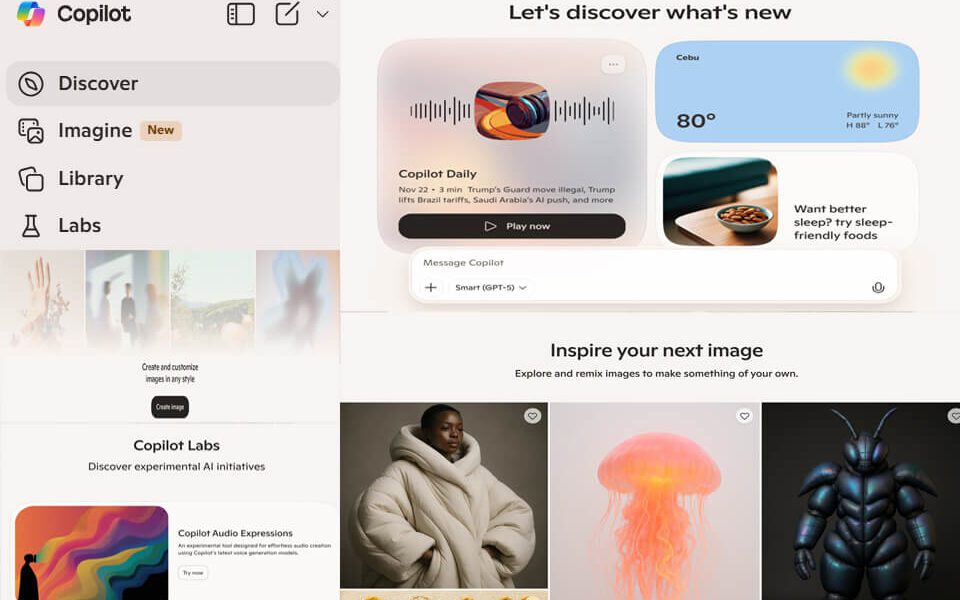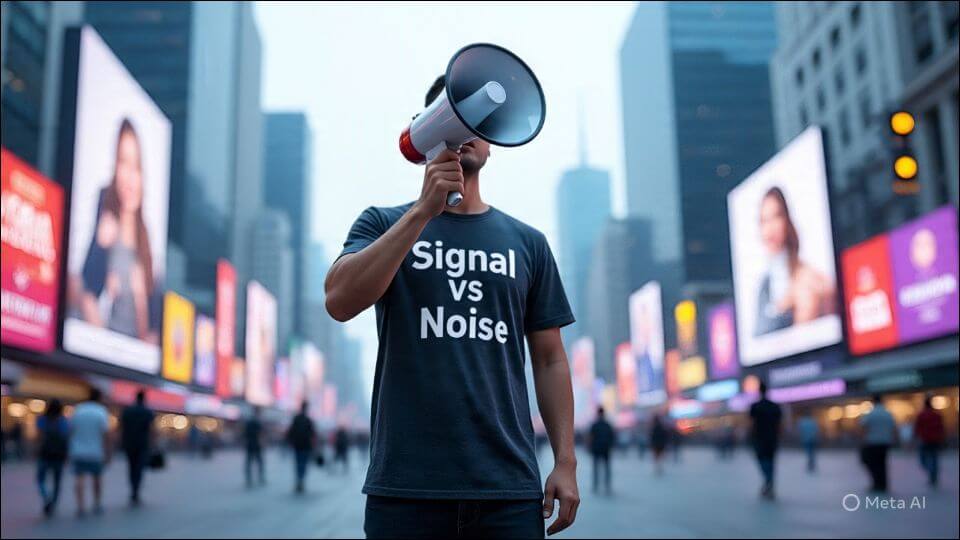AI tools shouldn’t feel like mysterious buttons in a cockpit. Copilot’s four modes—Discover, Imagine, Library, and Labs—are a practical, human workflow: how you find ideas, turn them into drafts, organize what works, and test what’s next. Think of it as an end-to-end studio that helps you go from “I have a vibe” to “I shipped it.”
🔎 Discover: Find signal, kill noise
Discover is where you gather inputs and patterns without drowning in tabs or opinions. It’s your “what’s worth paying attention to” room.
What it is
- Curated inputs: A space to explore examples, prompts, insights, and use cases relevant to your goal.
- Context builder: Helps you define audience, tone, constraints, and outcomes so later outputs don’t feel generic.
- Pattern spotting: Surface structures (hooks, formats, flows) that consistently perform.
Why it matters
- Quality in → Quality out: The best outputs start with clear constraints and good references.
- Faster alignment: Reduces back-and-forth because you set the brief properly up front.
- Repeatable wins: You capture formats that work (e.g., carousel skeletons, email sequences, ad angles).
Use it when
- You’re unclear on the angle: Need hooks, frames, or examples for a topic.
- You want what’s working now: Seeking proven templates you can adapt.
- You’re briefing collaborators: You need a shared “north star” before anyone starts building.
Blow-by-blow (quick path)
- Define the goal: What success looks like (reach, clicks, replies, sign-ups).
- Set context: Audience, tone, language, platform, constraints.
- Collect references: 3–5 strong examples of formats you want to emulate.
- Extract patterns: Identify hooks, structure, rhythm, CTA styles.
- Write the brief: One clear page you’ll hand to Imagine.
🎨 Imagine: Draft fast, iterate smarter
Imagine is where you turn your brief into tangible output—posts, scripts, visuals, copy—fast. It’s your “make it real” room.
What it is
- Generative drafting: Produces first versions based on your Discover brief.
- Style transfer: Keeps tone, vibe, and structure consistent with your chosen patterns.
- Iteration loop: Tighten, vary, and refine without starting from scratch every time.
Why it matters
- Speed with control: You don’t just get “something”; you get “your thing” faster.
- Exploration without chaos: Variation is guided by your constraints.
- Production-ready: You can move from rough to publishable in fewer cycles.
Use it when
- You’ve got a clear brief, and you want drafts in multiple angles (educational, satirical, direct-response).
- You need variants: Headlines, thumbnails, captions, scripts, and email A/B versions.
- You want modular assets: Reusable blocks you can rearrange across platforms.
Blow-by-blow (quick path)
- Feed the brief: Paste your Discover context and patterns.
- Draft v1: Generate the core piece (article, thread, video script, carousel).
- Spin variants: Ask for 3 versions (conservative, bold, playful).
- Tighten: Edit for clarity, brand voice, local nuance (Filipino realities, values).
- Package: Export final assets to Library (copy, captions, thumbnails, CTAs).
📚 Library: Save what works, scale what repeats
The library is where your proven assets live: templates, prompts, style guides, snippets, reusable blocks. It’s your “don’t reinvent it—reuse it” room.
What it is
- Central repository: Keeps best-performing pieces, prompts, formats, and checklists.
- Version control: Track iterations and performance notes (“v3 beat v2 by 18% CTR”).
- Modular blocks: Mix-and-match sections (hooks, intros, CTAs) for rapid production.
Why it matters
- Compounding returns: Every win becomes a template for the next.
- Team consistency: Anyone can produce in your voice, with your standards.
- Operational memory: You stop losing learnings in the chat abyss.
Use it when
- Something performed: Save the asset with notes (why it worked, where it works).
- You’re onboarding: Hand people the Library instead of explaining from scratch.
- You’re scaling: Turn single-use wins into repeatable workflows.
Blow-by-blow (quick path)
- Save the asset: Final draft + context + platform + goal.
- Tag and note: Audience, tone, hook type, performance highlights.
- Abstract the template: Strip specifics; keep the structure and language patterns.
- Create bundles: “Launch kit,” “Thread kit,” “Carousel kit,” “Email nurture kit.”
- Set rules: When to use, when not to use, how to adapt for local nuance.
🧪 Labs: Test, measure, and evolve
Labs is where you experiment—A/B test hooks, tones, formats, cadence. It’s your “prove it or kill it” room.
What it is
- Experiment engine: Structured tests on headlines, thumbnails, CTAs, lengths, and posting times.
- Feedback loop: Performance-informed tweaks (CTR, watch time, replies, saves).
- Risk sandbox: Try bold ideas safely and learn fast.
Why it matters
- No more guessing: Decisions based on signals, not vibes.
- Sharper instincts: You learn your audience’s real appetite (humor, depth, speed).
- Faster evolution: You ship better with each cycle and retire weak patterns.
Use it when
- You have variants: From Imagine and Library, ready to test.
- You need proof: Before scaling a format or investing in a campaign.
- You want growth: Systematic improvements across platforms.
Blow-by-blow (quick path)
- Pick one variable: Hook, headline, thumbnail, opening 10 seconds.
- Launch A/B: Two versions, same time window, same audience.
- Measure: Track CTR, watch time, replies, saves, shares.
- Decide: Keep the winner, tweak the loser, retire what fails twice.
- Document: Save learnings back into Library templates.
🧒 Too cryptic? Explain like I’m 12
- Discover: You look at good examples before you draw, so your drawing has a plan.
- Imagine: You make the drawing—lots of versions—until one looks great.
- Library: You save the best drawings and the steps, so next time is faster.
- Labs: You show two drawings to friends and keep the one they like more.
That’s it. You’re building a system that learns.
🚀 Quick-start playbook for a Filipino creator or micro-entrepreneur
- Goal: Sell a new digital service.
- Discover: Collect 5 winning local posts; extract hooks with dignity-first tone.
- Imagine: Draft a 10-tweet thread, a Facebook post, and a short Reel script; produce 3 variants.
- Library: Save the best thread, caption blocks, and CTA templates with notes.
- Labs: A/B test opening line (“quiet success” vs “scale without grind”), measure replies and saves.
- Scale: Turn the winner into a weekly series; build a “Service Launch Kit” bundle in Library.
📢 Viral takeaway
Copilot isn’t just “type-and-output.” It’s a production Studio:
- Discover: Choose better inputs.
- Imagine: Draft fast, iterate smart.
- Library: Keep the wins, scale the repeats.
- Labs: Test boldly, improve ruthlessly.
Use them as a chain. You won’t just create more—you’ll create with intent, consistency, and dignity.







